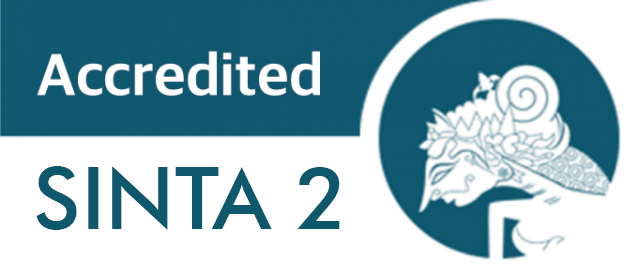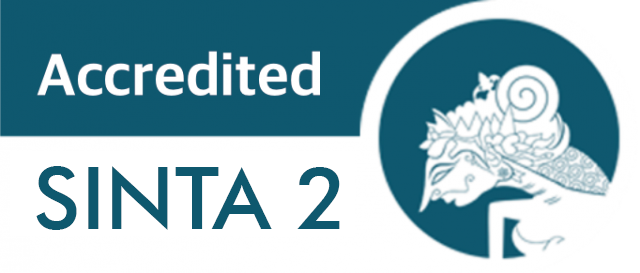The Correlation Between Fear of Missing Out (FoMO) and Internet Addiction in Vocational High School Students
Downloads
Abstracts
Background: Advanced and rapid technologic development has a great impact on the Indonesian education system. Indonesia was the sixth-largest internet users in the world. The increasing number of internet users potentially may increase the number of internet addicts caused by many factors, such as fear of missing out (FoMO). Objective: To determine the correlation between FoMO and internet addiction cases in Mitra Karya Mandiri Vocational High School, Brebes. Methods: This was a quantitative study with a cross-sectional design. Subjects of this study were all 11th-grade students of Mitra Karya Mandiri Vocational High School selected using a stratified random sampling method. The instruments used in this study was the Indonesian version of the sociodemographic questionnaire, the Internet Addiction Diagnostic questionnaire (KDAI) and the Fear of Missing Out questionnaire (FoMO-scale). Results: Most subjects (68.9%) did not have an internet addiction. There was a significant correlation between internet addiction with FoMO (p=0.009). The result of the ANOVA test showed that there were no significant differences in internet addiction from three majors of Mitra Karya Mandiri Vocational High School (p=0.586) and FoMO from three majors of Mitra Karya Mandiri Vocational High School (p=0.969). Conclusion: There was a significant correlation between internet addiction and FoMO. There was a significant correlation between internet addiction with gender and peer environment. However, there were no significant differences found between internet addiction and FoMO from each major.
Koc M. Internet Addiction and Psychopathology. Urkish Online J Educ Technol. 2011;(10) : 143-8p.
Asosiasi Penyelenggara Jasa Internet Indonesia. Info Grafis Penetrasi Dan Perilaku Pengguna Internet Indonesia: Survey. Asosiasi Penyedia Jasa Internet Indonesia; 2017.
Keung H. Internet Addiction and Antisocial Internet Behavior of Adolescents. Sci World J. 2011;(11), 2187–96. doi:10.1100/2011/308631.
Przybylski AK, Murayama K, Gladwell V. Motivational, Emotional And Behavioral Correlates Of Fear Of Missing Out. Comput Hum Behav. 2013;29:1841-48. doi: 10.1016/J.Chb.2013.02.014.
Walter TJ. Fear of missing out (FoMO). jwtintelligence. Published online 2012. https://www.jwtintelligence.com/wpcontent/uploads/2012/03/F_JWT_FOMO update_3.21.12.pdf
Marlina RD. Hubungan Antara Fear Of Missing Out (FoMO) Dengan Kecenderungan Kecanduan Internet Pada Emerging Adulthood. Thesis. Universitas Mercu Buana; 2017.
Timbung A. Hubungan Antara Fear Of Missing Out Dengan Intensitas Penggunaan Media Sosial Instagram Pada Mahasiswa Di Universitas Kristen Satya Wacana. Universitas Kristen Satya Wacana; 2017.
Santika G. Hubungan Antara Fear of Missing Out Dengan Kecanduan Internet Pada Remaja Di SMA 4 Bandung. Skripsi. Departemen Psikologi Universitas Pendidikan Indonesia; 2015.
Correa T, Hinsley AW, deZuniga H. Who interacts on the web?: The intersection of users' personality and social media use. Comput Human Behav. 2010;26(2): 247–53. http://doi.org/10.1016/j.chb.2009.09.003.
Mascheron G, Olafsson K. Mobile internet access and use among European children. Milano Educ. Published online 2013. http://eprints.lse.ac.uk/54244/1/Mobile internet access and use among European children_NCGM.pdf
Kemp S. Digital, social & mobile worldwide in 2015 / we are social. wearesocial. Published online 2015. http://wearesocial.net/blog/2015/01/digitalsocial-mobile-worldwide-2015/
National Statistics. Statistical Bulletin Internet Access - Households and Individuals Office for National Statistics. National Statistics; 2014.
Kementerian Pendidikan dan Kebudayaan. Kamus Besar Bahasa Indonesia (KBBI). Definisi Kata Kecanduan. Kementerian Pendidikan Dan Kebudayaan; 2015. http://kbbi.web.id/perilaku
Tim Prima Pena. Kamus Besar Bahasa Indonesia. Gitamedia Press; 2015.
Rosenberg K. Behavioral addictions: criteria, evidence and treatment. United States Am Elsevier. Published online 2014.
Yee N. The demographics, motivation and derived experiences of user of massively-multiuser online graphical environments. Presence Teleoperators Virtual Environ. 2012;(15): 309-29.
Young K. Internet Addiction: A Handbook and Guide to Evaluation and Treatment. John Wiley & Sons, Inc; 2010.
Kuss DJ, Griffits MD, Karila L, Billieux J. Internet addiction: A Systematic Review of Epidemiological Research for The Last Decade. UK: Curr Pharm Des [Internet]. 2014 [cited 2017 Feb 19];20(25):1–27. Available from: http://www.ncbi.nlm.nih.gov/pubmed/24001297
Montag C, Reuter M. Molecular genetics, personality and internet addiction. In C. Montag & M. Reuter (Eds.), Internet addiction, studies in neuroscience, psychology and behavioral economics. London Springer Int Publ. 2015;93-109pp.
Andreassen C, Griffiths M, Gjertsen S, Krossbakken E, Kvam S, Pallesen S. The relations between behavioral addiction and the five-factors model of personality. J Behav Addict. 2013;2(2):90-9.
Budysan T, Sidjaja F. Hubungan Antara Tipe Kepribadian Big Five Dengan Adiksi Internet Pada Mahasiswa Di Surabaya. J Exp. 2019;7(1): 31-4.
Andreassen CS. Online social network site addiction: a comprehensive review. Curr Addict Rep. 2015;2(2):175-84doi:10.1007/s40429-015-0056-9.
Hong F, Huang D, Lin H. Analysis of the psychological traits, facebook usage, and facebook addiction model of Taiwanese university students. Telemat Informatics. 2014;31(4):597-606. doi:10.1016/j.tele.2014.01.001.
Zhou Y, Li D, Li X, Wang Y, Zhao L. Big five personality and adolescent internet addiction: The mediating role of coping style. Addict Behav. 2016. doi: 10.1016/j.addbeh.2016.08.009.
Bernstein M, Claypool H, Young S, Tuscherer T, Sacco D, Brown C. Never Let Them See You Cry: Self Presentation as a Moderator of the Relationship Between Exclusion and Self-Esteem. Personal Soc Psychol Bull. 2013;39(10): 1293-1305.(http://doi.org/10.1177/0146167213495281).
Aydin B, Sari S. Internet addiction among adolescents: the role of self-esteem. Procedia Soc Behav Sci. 2011;(15): 3500-05.
Billieux J, Linden M. Problematic Use of the Internet and Self- Regulation: A Review of the Initial Studies. Open Addict J. 2012;(5): 24-9.
Andaryani D. Perbedaan tingkat self control pada remaja laki-laki dan remaja perempuan yang kecanduan internet. J Psikol Pendidik dan Perkembangan Fak Psikol. 2013;2 (3): 206-8.
Dossey L. FoMO, Digital Dementia And Our Dangerous Experiment. Exploration. 2014;10(2): 69-73.
Kuss D, Griffiths M. Internet and gaming addiction: A systematic literature review of neuroimaging studies. Brain Sci. 2012;2(3):347-74. doi:10.3390/brainsci2030347.
Press D. Clinical psychology of internet addiction : A review of its conceptualization , prevalence , neuronal processes , and implications for treatment. Press D. 2015;11-23.
Saliceti F. Internet Disorder. sbspro. 2015;(19): 1137-137. doi : 10.1016/j.sbspro.2015.04.292.
Chakraborty K, Basu D, Vijaya K. Internet addiction: consensus, controversies, and the way ahead. East Asian Arch Psychiatry. 2010;20(3):123–32. http://www.ncbi.nlm.nih.gov/pubmed/22348866
Lee Y, Han D, Kim S. Substance abuse precedes internet addiction. Addict Behav. 2013;38 (4): 2022-25. https://doi.org/10.1016/j.addbeh.2012.12.024.
Abel J, Cheryl L. Social media and fear of missing out: scale development and assessment. J Bus Econ Res. 2016;14(1): 33-43.
Tekeng S, Nurjanah Y. Peranan kepuasan kebutuhan dasar psikologis dan orientasi tujuan mastery approach terhadap belajar berdasar regulasi diri mahasiswa. Fak Psikol Univ Gadjah Mada Yogyakarta. Published online 2015.
Sugiyono. Metode Penelitian Kuantitatif, Kualitatif, Dan R&D. Alfabeta; 2011.
Dahlan M, Sopiyudin M. Besar Sampel Dan Cara Pengambilan Sampel Dalam Penelitian Kedokteran Dan Kesehatan. 3 Ed. Salemba Medika; 2010.
Sudigdo S. Dasar – Dasar Metodologi Penelitian Klinis. Sagung Seto; 2014.
Siste K. Kuesioner Diagnostik Adiksi Internet (KDAI). Fakultas Kedokteran Universitas Indonesia. 2019 Nov; Jakarta.
Sianipar N, Veronika D. Hubungan antara Regulasi Diri dengan Fear of Missing Out (FoMO) pada Mahasiswa Tahun Pertama Psikologi Universitas Diponegoro. Jurnal empati. Jan 2019; 8(1):136-43.
Aisyah F. Hubungan antara Fear of Missing Out (FoMO) dengan Kecanduan Media Sosial pada Remaja. Skripsi. Fakultas Psikologi dan Kesehatan. Universitas Islam Negri Sunan Ampel. Surabaya.2018.
Yansun MD, YangYang Li, Yangping B. Brief Report: Increase addictive Internet and Substance Use Behavior During The COVID-19 Pandemic in China. The American Journal on Addiction, 2020; 29: 268-70. doi : 10.1111/ajad.13066
Siste K, Hanafi E, Sen LT, Christian H, adrian, Siswidiani LP, Limawan AP, Murtani BJ and Suwartono C (2020). The Impact of Physical Distancing and Associated Factors Towards Internet Addiction Among Adults in Indonesian During COVID-19 Pandemic : A Nationwide. Web-Based Study. Front. Psychiatry 11: 580977. doi: 10.3389/fpsyt.2020.580977
Kalekhan F, Zacharia T, Addiction to social networking sites in healthcare students of a selected institution in Mangalore, Karnataka, India : A questionnaire study. India : International Journal of Applied Research. 2016;2(7):965–8
Gultom SA, Wardani ND, Fitrikasari A. Hubungan Adiksi Internet Dengan Prokrastinasi Akademik. Jurnal Kedokteran Diponegoro. Jan 2018; 7(1): 330-347
Copyright (c) 2023 Nur Setyaningsih , Widodo Sarjana , Natalia Dewi Wardani

This work is licensed under a Creative Commons Attribution-ShareAlike 4.0 International License.
1. Copyright of this journal is possession of the Author, by the knowledge of the Editorial Board and Journal Manager, while the moral right of the publication belongs to the author.
2. The journal allows the author(s) to retain publishing rights without restrictions.
3. The articles are published under a Creative Commons Attribution Share-Alike (CC BY-SA) license. Many research funding bodies prefer the CC BY-SA license because it allows for maximum dissemination and re-use of open access materials. Users are free to share (copy, distribute, and transmit) and remix (adapt) the contribution under this license, including for commercial purposes, as long as they attribute the contribution in the manner specified by the author or licensor.




























